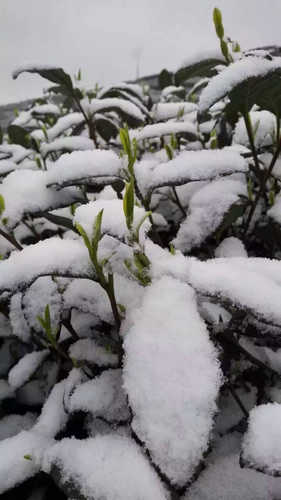Jiangnan (literally means River South, refers to the area south of the Yangtze River in eastern China) region is the biggest tea producing region in China. With low hills, abundant rainfall, distinct four seasons, this region represents two-thirds of the total production of the nation. Interestingly, a handful of high mountain ranges are all key producing sub-regions with teas of choice, aside from being scenic and hot tourists’ spots. Good economic-social conditions play a big supporting role in getting the names out – It’s not surprising that Keemun, Dragon Well, Bi Luo Chun all came from the River South region.
Cold spell
This year, China has been extensively affected by the strong cold air coming from the north since around March 8th. At this time of the year, when tea trees normally begin to sprout, any cold will inevitably cast a shadow on the spring harvest. The abrupt chill in the otherwise warm spring led to sharp temperature falls in southern China at large. Places like the Yangtze-Huai River area, south Yangtze River area, and the northern part of South China experienced declines of 6-8°C. Temperature in northern Jiangxi and northern Hunan Province even plummeted by 12-17°C.
New shoots on tea trees may be damaged by freezes and late frosts. The most susceptible are the first one or two sprouts, which, like being scalded, may turn brown and shrink in the sun. Many can no longer be plucked, and even those that can be picked will be lower in quality and thus sell cheaper.
Continuous rainfalls will certainly bring negative impacts to black tea production. As tea leaves should be processed soon after harvest, extended rainy periods are a big hindrance for black tea oxidation. This is because this sensitive stage of production must be timed for careful control of humidity, temperature and airflow.
Before the prevalence of the cold from March 7-13, some tea production areas in southern China enjoyed sunny days and relatively high temperatures. This actually lead to the plucking of green tea nearly 10 days earlier than last year. There will still be good harvest this year, only falling in overall quantity due to the chill. Therefore, one can expect the price of premium black and green tea produced later this year will likely to go up.
Tea review
Key tea type: Black and Dark
Key sub-region: Mt. Huangshan, Anhui
The blankets of nourishing mist that develops in the forests and valleys of Mt. Huang provides a natural shade against sunlight. This allows tea leaves to accumulate higher amino acid content, which is reflected in their robust sweetness.

Key tea type: Yellow
Key sub-region: Mt. Junshan, Hunan
Junshan Yinzhen is a celebrated yellow tea. Located next to Lake Dongting, in Yueyang prefecture, Hunan province. Junshan Yinzhen contains tender yellowish tips with fine white hair. It is developed further on green tea, adding a heaping process (covered moist heating) after pan-fired and before drying. Precisely because of the reason, yellow is slightly oxidized while green tea is un-oxidized. This gives the tea a mellow yet fresh taste as well as a yellowish color different from green tea.
Key tea type: Green
Key sub-region: West lake, Hangzhou, Zhejiang
This year has been very unlucky for the Dragon Well (Longjing). It was hit by the cold when it was time for sale, and the major production area in Hangzhou even met snowfall on March 9. The first batch of spring sprouts usually bode well for high-quality tea, because they boast the richest nutrition and best flavor and taste after an entire winter’s accumulation of nutrients. Unfortunately, the late chill has been culpable for frosting many freshest tea leaves. To cut loss, tea growers rushed to the hills with tea-plucking workers right after the snow to pick as many tender shoots as possible before the next possible cold spell.
Tasters’ tea recommendation
- Anji Baicha Green tea: “If you smell the tea, whether it is dry or after it’s steeped, you can sense a unique aroma that reminds you of the freshness after rain. It is relaxing, natural and pure. There is no flower fragrance or any other aroma, just the pure aroma of tea leaves. When you drink it, you will be impressed by the refreshing sweetness of the tea distinctly stronger than other types of green tea.” (by Shuying Gong)
- Qianxiang 1000 made by Huiliu Tea of Liu’an, Anhui. (by Daokun Ouyang)
Tea Market
Get More Value from Your Tea: BRU Maker One
+41794574278
Jacque's Organics
(647) 804-7263